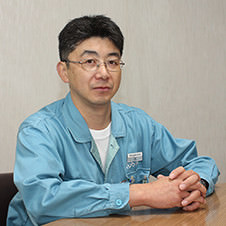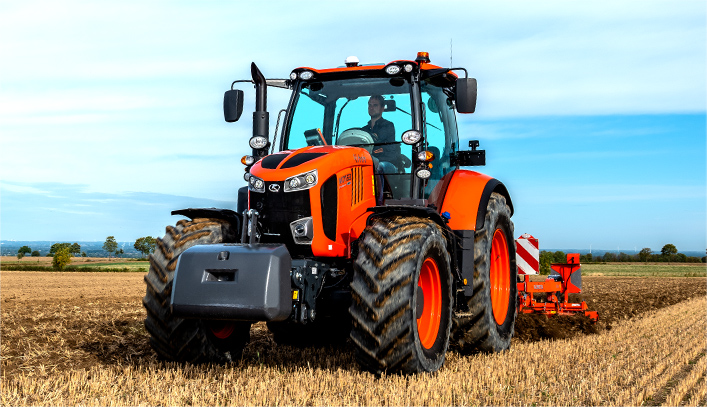02
Large Farming Tractors “M7001 Series”:Path of development

-
Comparison of crop acreage

Kubota's challenge in large scale commercial farming
Kubota established a production base for medium and large scale farming tractors in Spain in 1986 with the aim of expanding business in the EU region, starting with Spain. A slump in the Spanish agriculture industry, however, prompted Kubota to pull out of the country in 1994. Decades passed, but the challenge of entering the large scale commercial farming market remained as the most important and urgent issue for Kubota, whose management goals include contributing to solving the global food problems. Kubota's farming tractors and combine harvesters, which have been supplied mainly to Japan and other Asian coutries, have been highly approved by users. However, those products were primarily intended for rice farming. In world crop acreage, dry-field farming occupies roughly four times the acreage of rice farming. With this in mind, it is not an exaggeration to say that the door to solving global food problems cannot be opened without entering the large scale commercial farming business which spreads across the globe.
Seeing that the time was ripe, Kubota's top management made the long-awaited decision in 2010 to enter the market for large scale commercial farming. Kubota's target was Europe, which is one of the largest farming areas in the world. Entry into large scale commercial farming also entailed the development of large tractors, which was a venture into unknown territory for Kubota.
-

Left : Teruhito Yamauchi Team Leader, F37 Project, Second Design Office, Tractor Engineering Dept.
right : Motonari Inaoka Engineering Manager, Product Support Dept. KUBOTA FARM MACHINERY EUROPE S.A.S. (KFM)
Product concept: complete ease of use

Vehicle Basic Engineering Dept.
“Since the 1970s, Kubota has been supplying small tractors of around 50 horsepower to the European market, and it currently has the top share in Europe in this field. However, Kubota's small tractors are employed mainly in light civil engineering such as ground leveling in parks, pavement cleaning, and light work such as grass cutting. Dry-field farming applications, which are directly linked to production, including plowing and sowing, soil preparation, chemical spraying and carrying pasture in dairy farming, were a virtually untouched market for Kubota.
To make a full-scale entry into the market for large scale commercial farming, a project was started within Kubota in the winter of 2010. Four persons were called in: In addition to the aforementioned Yamada, Teruhito Yamauchi from the Research and Development Division (current position: F37 Project Team Leader, Second Design Office, Tractor Engineering Dept.), Motonari Inaoka, who had been involved in the development of tractors since joining the company, from the Design Division (current position: Engineering Manager, Product Support Dept., KUBOTA FARM MACHINERY EUROPE S.A.S. (KFM)), and Eiji Nishi, who is responsible for controls design (current position: Vehicle Basic Engineering Dept.). In early 2010, the four men flew to Europe for market research. The information to be gathered was wide-ranging: What are the needed horsepower ranges? What are the users looking for in large tractors? These and many more questions needed to be answered. What Inaoka, who was responsible for design, really felt was the deep trust the local users had in Kubota.
“We received many requests for large tractors from farmers who were using small tractors. Aspiring to create products that would meet their expectations, we spent about a year formulating the product concept. As a result, we decided to set our target as the 130-170 horsepower range and started the development of large tractors.”
In the large tractor market, however, Kubota was a new entrant, and our competitors already had full a lineup of products. Customers would never choose Kubota tractors unless we strived to establish market supremacy and clear differentiation. Moreover, the design concept of upland farming tractors was fundamentally different from that of rice farming tractors. Tractors are usually equipped with operating equipment called “implements” for effective use. Whereas rice farming tractors require light vehicle weight because they are used in rice fields, upland farming tractors require larger vehicle weight because of the need to attach large implements. In addition to increasing vehicle weight, Inaoka's team concluded that they should maintain the strength Kubota had cultivated in the rice farming market, which was fine-tuned operability.
Required basic specs for tractors do not differ much by manufacturer. We have long years of experience and a proven track record in developing tractors with a focus on ease of use. In the all-out pursuit of ease of use, we made it the basic concept of our large tractors.” (Inaoka)
Also incorporating the technology of Kverneland AS
Inaoka's team verified all the functions inside the cabin, one by one. Particular attention was given to design of the multifunction lever, which enables tractor operation with one lever. In order to significantly reduce operator burden, the layout of switches and armrests inside the cabin was optimized and operating elements were concentrated near the hands of the operator. As a result, the new design minimized operator fatigue even over long hours of operation. European agriculture typified by France is also referred to as mixed farming. It ranges from dry-field crops such as wheat and corn, dairy/ livestock such as dairy products and meat, and fruit production such as grape and olive, and customer needs for tractors are also diversified. To address these needs, Kubota's large tractor design enabled detailed customization, from cabin configuration to tires. In early 2012, Kubota began fabricating the first prototype of a large tractor and also made the bold move of essentially announcing its entry into large scale commercial farming to the world: Kubota acquired “Kverneland AS” of Norway and made it a Kubota Group company. Kverneland AS is a manufacturer of implements for tractors that has strong brand power in Europe, a wide range of products and high technical capability. This acquisition gave Kubota the advantage of being able to develop large tractors that are best matched to implements for dry-field farming.
-

A wide variety of implements for dry-field farming, which are used for different applications such as plowing and sowing, soil preparation, chemical spraying and carrying pasture in dairy farming. The newly-developed M7001 undertakes all of these diverse, heavy works. -

A wide variety of implements for dry-field farming, which are used for different applications such as plowing and sowing, soil preparation, chemical spraying and carrying pasture in dairy farming. The newly-developed M7001 undertakes all of these diverse, heavy works. -

A wide variety of implements for dry-field farming, which are used for different applications such as plowing and sowing, soil preparation, chemical spraying and carrying pasture in dairy farming. The newly-developed M7001 undertakes all of these diverse, heavy works. -

A wide variety of implements for dry-field farming, which are used for different applications such as plowing and sowing, soil preparation, chemical spraying and carrying pasture in dairy farming. The newly-developed M7001 undertakes all of these diverse, heavy works.
